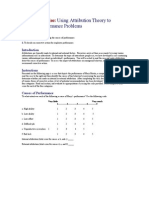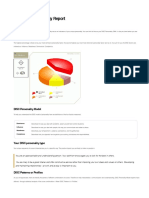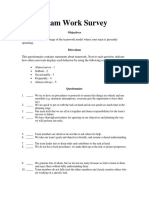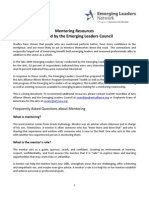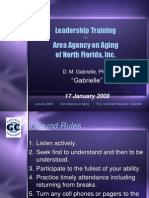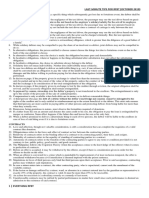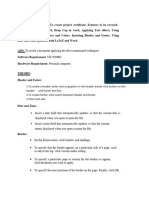Risb Scoring Manual
Risb Scoring Manual
Uploaded by
Tauseef FatimaCopyright:
Available Formats
Risb Scoring Manual
Risb Scoring Manual
Uploaded by
Tauseef FatimaOriginal Description:
Original Title
Copyright
Available Formats
Share this document
Did you find this document useful?
Is this content inappropriate?
Copyright:
Available Formats
Risb Scoring Manual
Risb Scoring Manual
Uploaded by
Tauseef FatimaCopyright:
Available Formats
Risb scoring manual pdf
Learning Objectives Describe different types of personality tests, including the Minnesota Multiphasic Personality Inventory and common projective tests Roberto, Mikhail, and Nat are college friends and all want to be police officers. Roberto is quiet and shy, lacks self-confidence, and usually follows others. He is a kind person, but lacks motivation.
Mikhail is loud and boisterous, a leader. He works hard, but is impulsive and drinks too much on the weekends.
Nat is thoughtful and well liked. He is trustworthy, but sometimes he has difficulty making quick decisions. Of these three men, who would make the best police officer? What qualities and personality factors make someone a good police officer? What makes someone a bad or dangerous police officer? A police officer’s job is very high in stress, and
law enforcement agencies want to make sure they hire the right people. Personality testing is often used for this purpose—to screen applicants for employment and job training. Personality tests are also used in criminal cases and custody battles, and to assess psychological disorders. This section explores the best known among the many different
types of personality tests. Self-report inventories are a kind of objective test used to assess personality. They typically use multiple-choice items or numbered scales, which represent a range from 1 (strongly disagree) to 5 (strongly agree). They often are called Likert scales after their developer, Rensis Likert (1932) (Figure 1). Figure 1.
If you’ve ever taken a survey, you are probably familiar with Likert-type scale questions. Most personality inventories employ these types of response scales. One of the most widely used personality inventories is the Minnesota Multiphasic Personality Inventory (MMPI), first published in 1943, with 504 true/false questions, and updated to the MMPI-2
in 1989, with 567 questions. The original MMPI was based on a small, limited sample, composed mostly of Minnesota farmers and psychiatric patients; the revised inventory was based on a more representative, national sample to allow for better standardization. The MMPI-2 takes 1–2 hours to complete. Responses are scored to produce a clinical
profile composed of 10 scales: hypochondriasis, depression, hysteria, psychopathic deviance (social deviance), masculinity versus femininity, paranoia, psychasthenia (obsessive/compulsive qualities), schizophrenia, hypomania, and social introversion. There is also a scale to ascertain risk factors for alcohol abuse. In 2008, the test was again revised,
using more advanced methods, to the MMPI-2-RF. This version takes about one-half the time to complete and has only 338 questions (Figure 2). Despite the new test’s advantages, the MMPI-2 is more established and is still more widely used. Typically, the tests are administered by computer. Although the MMPI was originally developed to assist in
the clinical diagnosis of psychological disorders, it is now also used for occupational screening, such as in law enforcement, and in college, career, and marital counseling (Ben-Porath & Tellegen, 2008). Figure 2.
These true/false questions resemble the kinds of questions you would find on the MMPI. In addition to clinical scales, the tests also have validity and reliability scales. (Recall the concepts of reliability and validity from your study of psychological research.) One of the validity scales, the Lie Scale (or “L” Scale), consists of 15 items and is used to
ascertain whether the respondent is “faking good” (underreporting psychological problems to appear healthier). For example, if someone responds “yes” to a number of unrealistically positive items such as “I have never told a lie,” they may be trying to “fake good” or appear better than they actually are. Reliability scales test an instrument’s
consistency over time, assuring that if you take the MMPI-2-RF today and then again 5 years later, your two scores will be similar. Beutler, Nussbaum, and Meredith (1988) gave the MMPI to newly recruited police officers and then to the same police officers 2 years later. After 2 years on the job, police officers’ responses indicated an increased
vulnerability to alcoholism, somatic symptoms (vague, unexplained physical complaints), and anxiety. When the test was given an additional 2 years later (4 years after starting on the job), the results suggested high risk for alcohol-related difficulties. Another method for assessment of personality is . This kind of test relies on one of the defense
mechanisms proposed by Freud—projection—as a way to assess unconscious processes. During this type of testing, a series of ambiguous cards is shown to the person being tested, who then is encouraged to project his feelings, impulses, and desires onto the cards—by telling a story, interpreting an image, or completing a sentence.
Many projective tests have undergone standardization procedures (for example, Exner, 2002) and can be used to access whether someone has unusual thoughts or a high level of anxiety, or is likely to become volatile. Some examples of projective tests are the Rorschach Inkblot Test, the Thematic Apperception Test (TAT), the Contemporized-Themes
Concerning Blacks test, the TEMAS (Tell-Me-A-Story), and the Rotter Incomplete Sentence Blank (RISB). The was developed in 1921 by a Swiss psychologist named Hermann Rorschach (pronounced “ROAR-shock”). It is a series of symmetrical inkblot cards that are presented to a client by a psychologist. Upon presentation of each card, the
psychologist asks the client, “What might this be?” What the test-taker sees reveals unconscious feelings and struggles (Piotrowski, 1987; Weiner, 2003). The Rorschach has been standardized using the Exner system and is effective in measuring depression, psychosis, and anxiety. A second projective test is the Thematic Apperception Test (TAT),
created in the 1930s by Henry Murray, an American psychologist, and a psychoanalyst named Christiana Morgan. A person taking the TAT is shown 8–12 ambiguous pictures and is asked to tell a story about each picture. The stories give insight into their social world, revealing hopes, fears, interests, and goals. The storytelling format helps to lower a
person’s resistance divulging unconscious personal details (Cramer, 2004). The TAT has been used in clinical settings to evaluate psychological disorders; more recently, it has been used in counseling settings to help clients gain a better understanding of themselves and achieve personal growth. Standardization of test administration is virtually
nonexistent among clinicians, and the test tends to be modest to low on validity and reliability (Aronow, Weiss, & Rezinkoff, 2001; Lilienfeld, Wood, & Garb, 2000). Despite these shortcomings, the TAT has been one of the most widely used projective tests. A third projective test is the Rotter Incomplete Sentence Blank (RISB) developed by Julian
Rotter in 1950 (recall his theory of locus of control, covered earlier in this chapter). There are three forms of this test for use with different age groups: the school form, the college form, and the adult form. The tests include 40 incomplete sentences that people are asked to complete as quickly as possible (Figure 3). The average time for completing
the test is approximately 20 minutes, as responses are only 1–2 words in length. This test is similar to a word association test, and like other types of projective tests, it is presumed that responses will reveal desires, fears, and struggles. The RISB is used in screening college students for adjustment problems and in career counseling (Holaday, Smith,
& Sherry, 2010; Rotter & Rafferty 1950). Figure 3.
These incomplete sentences resemble the types of questions on the RISB. How would you complete these sentences? For many decades, these traditional projective tests have been used in cross-cultural personality assessments. However, it was found that test bias limited their usefulness (Hoy-Watkins & Jenkins-Moore, 2008). It is difficult to assess
the personalities and lifestyles of members of widely divergent ethnic/cultural groups using personality instruments based on data from a single culture or race (Hoy-Watkins & Jenkins-Moore, 2008). For example, when the TAT was used with African-American test takers, the result was often shorter story length and low levels of cultural identification
(Duzant, 2005). Therefore, it was vital to develop other personality assessments that explored factors such as race, language, and level of acculturation (Hoy-Watkins & Jenkins-Moore, 2008). To address this need, Robert Williams developed the first culturally specific projective test designed to reflect the everyday life experiences of African Americans
(Hoy-Watkins & Jenkins-Moore, 2008). The updated version of the instrument is the Contemporized-Themes Concerning Blacks Test (C-TCB) (Williams, 1972). The C-TCB contains 20 color images that show scenes of African-American lifestyles. When the C-TCB was compared with the TAT for African Americans, it was found that use of the C-TCB led
to increased story length, higher degrees of positive feelings, and stronger identification with the C-TCB (Hoy, 1997; Hoy-Watkins & Jenkins-Moore, 2008). The TEMAS Multicultural Thematic Apperception Test is another tool designed to be culturally relevant to minority groups, especially Hispanic youths. TEMAS—standing for “Tell Me a Story” but
also a play on the Spanish word temas (themes)—uses images and storytelling cues that relate to minority culture (Constantino, 1982). Watch this CrashCourse video to better understand how personality is measured: You can view the transcript for “Measuring Personality: Crash Course Psychology #22” here (opens in new window). Think It Over
How objective do you think you can be about yourself in answering questions on self-report personality assessment measures? What implications might this have for the validity of the personality test?
personality test composed of a series of true/false questions in order to establish a clinical profile of an individual personality assessment in which a person responds to ambiguous stimuli, revealing hidden feelings, impulses, and desires projective test that employs a series of symmetrical inkblot cards that are presented to a client by a psychologist in
an effort to reveal the person’s unconscious desires, fears, and struggles projective test in which people are presented with ambiguous images, and they then make up stories to go with the images in an effort to uncover their unconscious desires, fears, and struggles projective test that is similar to a word association test in which a person completes
sentences in order to reveal their unconscious desires, fears, and struggles projective test designed to be culturally relevant to African Americans, using images that relate to African-American culture projective test designed to be culturally relevant to minority groups, especially Hispanic youths, using images and storytelling that relate to minority
culture
You might also like
- Communication Preference Guidebook 1Document44 pagesCommunication Preference Guidebook 1Sachin ParasharNo ratings yet
- Team Climate InventoryDocument25 pagesTeam Climate InventoryLucia AlvarezNo ratings yet
- Group DynamicsDocument7 pagesGroup Dynamicsranjana30No ratings yet
- 7 Group Exercise Using Attribution TheoryDocument3 pages7 Group Exercise Using Attribution TheoryOlta KodraNo ratings yet
- Building A House For Diversity-Giraffe An ElephantDocument2 pagesBuilding A House For Diversity-Giraffe An Elephantvani1401No ratings yet
- Blake and Mouton Leadership Styles QuestionnaireDocument6 pagesBlake and Mouton Leadership Styles QuestionnaireBhaskaran BalamuraliNo ratings yet
- Stages of Team DevelopmentDocument6 pagesStages of Team DevelopmentMonu JainNo ratings yet
- Alban Metcalfe 2013Document18 pagesAlban Metcalfe 2013Musadaq HanandiNo ratings yet
- My Leadership StyleDocument6 pagesMy Leadership Styleapi-270957642No ratings yet
- Leadership's TheoryDocument3 pagesLeadership's TheorySinwar YogitaNo ratings yet
- Organizational Conflict QuestionnaireDocument2 pagesOrganizational Conflict Questionnaireapi-562040967100% (1)
- Strengths Assessment ReflectionDocument2 pagesStrengths Assessment Reflectionapi-361189519No ratings yet
- R.A.K Colege of Nursing, New Delhi: Subject:-Educational Methods and MediaDocument12 pagesR.A.K Colege of Nursing, New Delhi: Subject:-Educational Methods and MediaIkhsan As Hamba AllohNo ratings yet
- Leadership Style Self AssessmentDocument5 pagesLeadership Style Self Assessmentapi-282129457No ratings yet
- DiscDocument3 pagesDiscapi-523050935No ratings yet
- Personality: Click To Edit Master Subtitle StyleDocument19 pagesPersonality: Click To Edit Master Subtitle StyleDrNiharika SinghNo ratings yet
- Conceptual Framework On Psychological Ownership As Predictor of Turnover Intentions PDFDocument21 pagesConceptual Framework On Psychological Ownership As Predictor of Turnover Intentions PDFSaketNo ratings yet
- Brain Orientation AssessmentDocument8 pagesBrain Orientation Assessmentapi-373196015No ratings yet
- The Ultimate EducatorDocument14 pagesThe Ultimate EducatorAlexander Antonio Ortega AlvarezNo ratings yet
- Victor Broom ScientistDocument11 pagesVictor Broom ScientistAnil Kumar SharmaNo ratings yet
- Uganda Management Institute (Umi) : CourseDocument11 pagesUganda Management Institute (Umi) : CourseHenok FikaduNo ratings yet
- Leadership: Osorio - Paigan - Pantaleon - Peñaflor - Peñaflorida - Pregil - Reliquias - Rodinas - SaldoDocument92 pagesLeadership: Osorio - Paigan - Pantaleon - Peñaflor - Peñaflorida - Pregil - Reliquias - Rodinas - SaldoGlaze Rodinas100% (1)
- DISC AssessmentDocument4 pagesDISC AssessmentPablo Casas MéndezNo ratings yet
- Emotional Intelligence in LeadershipDocument5 pagesEmotional Intelligence in LeadershipInternational Journal of Innovative Science and Research TechnologyNo ratings yet
- Introduction& Context: Technical and Job-Related Skills Are Must, But They Are Not SufficientDocument3 pagesIntroduction& Context: Technical and Job-Related Skills Are Must, But They Are Not SufficientKiran RavariyaNo ratings yet
- Reverse MentoringDocument20 pagesReverse MentoringmaxsoniiNo ratings yet
- Personality Type PreferencesDocument24 pagesPersonality Type PreferencesJeffrey WangNo ratings yet
- Formation of Group PDFDocument10 pagesFormation of Group PDFabid hussainNo ratings yet
- Customer Style InventoryDocument9 pagesCustomer Style InventoryPRATICK RANJAN GAYEN50% (2)
- Primal Leadership - The Hidden Driver of Great PerformanceDocument3 pagesPrimal Leadership - The Hidden Driver of Great PerformanceRiyoHussainMNo ratings yet
- Creating A Positive Team ClimateDocument42 pagesCreating A Positive Team ClimateBerin Surkovic100% (2)
- Law Wong Song (2004) JAPDocument14 pagesLaw Wong Song (2004) JAPUmair ArshadNo ratings yet
- Likert's Management SystemDocument1 pageLikert's Management SystemMalay EbajoNo ratings yet
- Putting The "Leader" in LeadershipDocument187 pagesPutting The "Leader" in LeadershipSarah Kath100% (3)
- Strategic Leadership Knowledge ManagementDocument14 pagesStrategic Leadership Knowledge ManagementAlthea mayNo ratings yet
- ESCI ArticleDocument11 pagesESCI Articleerg2100% (2)
- Leadership Trait Questionaire NorthhouseDocument3 pagesLeadership Trait Questionaire NorthhouseHafsa Rehan100% (1)
- Constructive FeedbackDocument6 pagesConstructive FeedbackBella BellaNo ratings yet
- 0809 Tuckman Team Work SurveyDocument3 pages0809 Tuckman Team Work Surveykuldip singh100% (1)
- Firo-B: Fundamental Interpersonal Relations OrientationDocument8 pagesFiro-B: Fundamental Interpersonal Relations Orientationsumit.jainNo ratings yet
- Transition From IC To ManagerDocument5 pagesTransition From IC To ManagersantoshladNo ratings yet
- Preceptor Training Course OutlineDocument4 pagesPreceptor Training Course Outlineapi-302310876100% (1)
- Enrolled Nurse Self-Assessment/Appraisal Tool and Professional Development Plan BookletDocument24 pagesEnrolled Nurse Self-Assessment/Appraisal Tool and Professional Development Plan Bookletscience pathNo ratings yet
- LEI E Tertxercise RetrgretuideDocument18 pagesLEI E Tertxercise RetrgretuiderafaelkiNo ratings yet
- Final Mentoring ResourcesDocument6 pagesFinal Mentoring Resourcessamknight2009No ratings yet
- Emotional Intelligence Training: Case Study - MedradDocument2 pagesEmotional Intelligence Training: Case Study - MedradIHHPManager100% (2)
- 022 Workplace Stress Evaluation ToolsDocument36 pages022 Workplace Stress Evaluation ToolsISCRRNo ratings yet
- Ldrs 802 Final ProjectDocument5 pagesLdrs 802 Final Projectapi-316465716No ratings yet
- Mediation - Skills and Qualities of A MediatorDocument4 pagesMediation - Skills and Qualities of A MediatorAakashMalhotraNo ratings yet
- Organizational Systems Change Leadership Final ExamDocument7 pagesOrganizational Systems Change Leadership Final Examapi-545443926No ratings yet
- Factors Affecting Prevalence of Reverse Mentoring in IndiaDocument6 pagesFactors Affecting Prevalence of Reverse Mentoring in IndiaInternational Journal of Business Marketing and ManagementNo ratings yet
- Leadership Training Area Agency On Aging of North Florida, IncDocument38 pagesLeadership Training Area Agency On Aging of North Florida, Incdt6813100% (1)
- Educational LeadershipDocument23 pagesEducational LeadershipThea Margareth MartinezNo ratings yet
- Charismatic LeadershipDocument5 pagesCharismatic Leadershippoosindhu16No ratings yet
- Literature ReviewDocument41 pagesLiterature ReviewMunguongeyo Ivan100% (1)
- MGT 3013 Questions Ch10Document51 pagesMGT 3013 Questions Ch10skamaleoNo ratings yet
- Change and Thrive: A Modern Approach to Change LeadershipFrom EverandChange and Thrive: A Modern Approach to Change LeadershipNo ratings yet
- Be a Better Boss: Learn to build great teams and lead any organization to successFrom EverandBe a Better Boss: Learn to build great teams and lead any organization to successNo ratings yet
- OOPS-Python - Jupyter NotebookDocument4 pagesOOPS-Python - Jupyter NotebookSubhamita KanungoNo ratings yet
- A Brief Guide To Creating Custom Target Curves in Dirac Live Rev 2.1Document16 pagesA Brief Guide To Creating Custom Target Curves in Dirac Live Rev 2.12011-johndoeNo ratings yet
- Cola-Game Supply ChainDocument21 pagesCola-Game Supply ChainJackie BaughmanNo ratings yet
- Definition of Cross Functional Information SystemDocument2 pagesDefinition of Cross Functional Information SystemSyed Imran68% (19)
- Practical Research 1: Quarter 1 - Module 1Document24 pagesPractical Research 1: Quarter 1 - Module 1Emelyn Angeles100% (1)
- Last Minute Tips (October 2019)Document6 pagesLast Minute Tips (October 2019)Jaye ManangoNo ratings yet
- Readyornot FinalDocument80 pagesReadyornot FinalLililah Bint leyNo ratings yet
- PostgreSQL Cassandra UpgradeDocument41 pagesPostgreSQL Cassandra UpgradeRužica PrljevićNo ratings yet
- 3 (Task-2)Document2 pages3 (Task-2)SrinivasaReddyMNo ratings yet
- Costs Management For A Profitable New Product Development: Facta UniversitatisDocument8 pagesCosts Management For A Profitable New Product Development: Facta UniversitatissrdjaNo ratings yet
- PWS6500 Hardware ManualDocument15 pagesPWS6500 Hardware ManualOmar Alberto Quisbert Tapia100% (1)
- 203 - 2024 Regional U18 Boys Trials For The Academy Engen Team 24042024-1Document2 pages203 - 2024 Regional U18 Boys Trials For The Academy Engen Team 24042024-1sizzyshomeNo ratings yet
- Botswana Withholding Tax RatesDocument4 pagesBotswana Withholding Tax Ratesjiwon leeNo ratings yet
- Vetting Oil TankerDocument13 pagesVetting Oil Tankershardulshinde67% (3)
- Geylang Physics P2Document20 pagesGeylang Physics P2wi.nn.yNo ratings yet
- Tutorial A.A.G. Stucchi Light Control AppDocument30 pagesTutorial A.A.G. Stucchi Light Control Appdfgdfbf dfgdgdfgNo ratings yet
- Marvel KnightsDocument52 pagesMarvel KnightsDave Baymiller100% (2)
- Quiz M4Document4 pagesQuiz M4FRANCIS YEGONo ratings yet
- Sea Container Quarantine Declaration Sechulde 2 SEACODocument1 pageSea Container Quarantine Declaration Sechulde 2 SEACOJeremia PattinussaNo ratings yet
- Iso 10962Document7 pagesIso 10962darezzo.guido0% (1)
- Terms & Conditions - GRAHSP Project Bhutan 12072023Document2 pagesTerms & Conditions - GRAHSP Project Bhutan 12072023Praveenkumar KanagarajNo ratings yet
- Excavation SafetyDocument31 pagesExcavation SafetyAhmad AliNo ratings yet
- Tawara CollegeDocument6 pagesTawara Collegearcturusgrey70No ratings yet
- Bowtie Pro™: Customising Diagrams in Version 3.3Document10 pagesBowtie Pro™: Customising Diagrams in Version 3.3RafaelNo ratings yet
- 25 Statement of Financial Position- Sample Answers to Short Answer and Data Response Question 1Document2 pages25 Statement of Financial Position- Sample Answers to Short Answer and Data Response Question 1Aariish SinghiNo ratings yet
- Guide For Training in SMEsDocument84 pagesGuide For Training in SMEsdmaproiectNo ratings yet
- Southwest Airline Case StudyDocument4 pagesSouthwest Airline Case Studydale_938841649No ratings yet
- Purlins 3 PDFDocument35 pagesPurlins 3 PDFrajNo ratings yet
- Unit 2 Living and GrowingDocument3 pagesUnit 2 Living and GrowingSyukron RizqiNo ratings yet
- TA TLE 7 EstimationDocument4 pagesTA TLE 7 EstimationGrace Dagohoy BeeNo ratings yet



